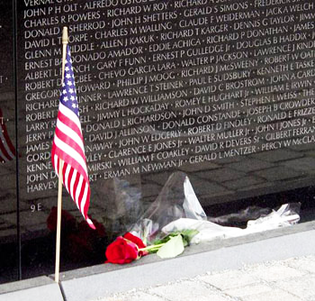 Remembering Remembering Remembering Remembering Reflections on the Wall By Rafael Jesús González For sometime now, I have shared my thoughts during my visit to the Vietnam Memorial in 2006 as my way of honoring Memorial Day: Reflections on the Wall My first day in Washington D.C., in the heat of August, straight from the Museum of the American Indian, wearing my T-shirt picturing the Apache Gerónimo and his armed companions and reading, "Homeland Security, Fighting Terrorism since 1492," I walk down the Mall, skirt the obelisk of the Washington Monument, down the reflecting pool, past the white marble Greek temple of the Lincoln Monument, to the Viet-Nam Wall - a pilgrimage to the memorial to "my war," mine not because I fought in it, but because I fought against it - heart, mind, and soul. My intent, a kind of penance, like saying the rosary, is to start at one end to the other and read each and every one of the 58,245 names, imagining a face, an age, a history, a life. I know it will be hard, but do not think it impossible (not one of the five million names of the Vietnamese dead are even alluded to.) I start with one name, John H. Anderson Jr. (PFC, 19 years of age, dead May 25, 1968, I later look up in the log), then several, increasing exponentially. It becomes more and more difficult to focus, the faces, the figures of families, lovers, tourists reflected moving against the mirroring black granite Wall is a distraction, their chatter, at times their laughter, an intrusion upon my meditations. As the Wall grows longer, rises higher and higher toward the center, the names crowd upon each other, pile up high and tight, at times difficult to distinguish, I do not know if for the numbers, the height, for the glare of the sun, or for the tears welling in my eyes. The names, the letters blur, run together. I begin to skim, to let my attention chance upon a name, a Smith, a Cohen, a Bankowski, an O'Mally, a Chan, certainly a González here and there - every European and many another culture represented by a name. How came they to be there, what history of need, what myth or dream of theirs, or of some recent or distant ancestor, brought them to be "American" and die in a war without sense or reason? After a time my reading becomes cursory, I occasionally stop, kneel to pick up and read a letter, a note of testimonial - of love, of remembrance - left at the foot of the Wall by some surviving wife, sweetheart, mother, father, son, daughter, brother, sister, nephew, niece, friend. A flag here and there, a flower (mostly artificial, a few in soda bottles, wilting in the heat.) My mind gradually becomes numb, at times almost hallucinatory, wonders -imagines seeing the name there of a moneyed coward with powerful political connections that now inhabits a white house not far away. * * * They say the dead live on for as long as they are remembered. How many of these names etched here are still remembered? A few people, holding scraps of paper against the black stone make rubbings. Most hurry by, the kids impatient to reach the end, the names picked there not interesting enough to hold their attention. The names. Last year, Xochipilli, my men's ritual group, in collaboration with the 'Faces of the War Project,' created an Ofrenda to the Victims of War for the Días de los Muertos Community Celebration at the Oakland Museum of California. The ofrenda stood against the walls lined with the photographs and names of the U. S. soldiers dead in Iraq, the names, without the photographs, of Iraqi dead. The names, still fresh, living in recent memory. Another war, as senseless, as irredeemable as that of Viet-Nam. I am tired, my face wet with sweat and tears I do not bother to wipe away. Tourists look at me, respectfully keep their distance, look away. They sense that this, that of Viet-Nam, is my war; I do not know if my shirt gives them a clue as to why. * * * I reach the other end of the Wall, Jessie Charles Alba (Sgt., aged 20, dead May 25, 1968, the middle of the war.) * * * Retracing my way up the reflecting pool, I must climb the steps of the Lincoln Memorial from which Marian Anderson once sang, from which Martin Luther King, Jr. spoke of his dream. I stand before the colossal figure of Lincoln enthroned and read his words chiseled into the white marble to his right: " . . . a government of the people, for the people, by the people . . ." A pious hope devoutly to be wished. Reflexiones sobre el Muro Por Rafael Jesús González El primer día en Washington D.C., en el calor de agosto, justo del Museo del Indio Americano, llevo mi camiseta con la imagen del apache Gerónimo y sus compañeros armados que lee, "Homeland Security, Luchando contra el Terrorismo desde 1492." Camino por la alameda, el Mall, rodeo el obelisco del monumento a Washington, sigo la alberca, paso el templo griego de mármol blanco del monumento a Lincoln, al Muro de Vietnam - peregrinaje al monumento a "mi guerra," mía no porque luché en ella, sino porque luché en oposición de ella - corazón, mente y alma. Mi intención, un tipo de penitencia, como decir el rosario, es empezar de una punta a la otra y leer cada uno y todos los 58, 245 nombres, imaginándome un rostro, una edad, una historia, una vida. Sé que será difícil, pero no lo creo imposible (ni siquiera se alude ni a uno de los cinco millones de nombres de los vietnamitas muertos.) Empiezo con un nombre, John H. Anderson Jr. (PFC, 19 años de edad, muerto el 25 de mayo 1968, más tarde busco en la lista), luego varios, aumentando exponentemente. Se me hace más y más difícil enfocarme, las caras, las figuras de familias, amantes, turistas reflejados moviéndose contra el espejo del Muro de granito negro es una distracción, su parloteo, a veces su risa, una intrusión en mis meditaciones. A grado que el Muro se hace más largo, se eleva más y más alto hacia el centro, los nombres se amontonan uno sobre el otro, se amontonan alto y apretado, a veces difíciles de distinguir, no sé si por la cantidad, la altura, el relumbre del sol o las lágrimas que me llenan los ojos. Los nombres, las letras se borran, se corren una contra la otra. Empiezo a pasar los nombres por en cima, dejar mi atención caer sobre un nombre u otro, un Smith, un Cohen, un Bankowski, un O'Mally, un Chan, indudablemente un González aquí y allá - toda cultura Europea y muchas otras representadas por un nombre. ¿Cómo llegaron a estar allí, que historia de necesidad, que mito o sueño suyo, o de algún antepasado reciente o lejano, los trajeron a ser "americano" y morir en una guerra sin sentido o razón? Después de algún tiempo mi lectura se hace superficial, paro de vez en cuando, me arrodillo a levantar y leer una carta, una nota de testimonio - de amor, de recuerdo - depositada al pie del Muro por algún sobreviviente, esposa, novia, madre, padre, hij@, herman@, sobrin@, amig@. Una bandera aquí y allá, una flor (la mayoría artificiales, unas cuantas en botellas de refresco, marchitándose en el bochorno. La mente se me entume gradualmente, a veces casi halucinante, se desvía - imagina ver allí el nombre de un cobarde adinerado con conexiones políticas poderosas que ahora habita una casa blanca no lejos de aquí. * * * Dicen que los muertos viven mientras sean recordados. ¿Cuántos de los nombres aquí grabados son aun recordados? Algunas personas, poniendo trozos de papel contra la piedra negra hacen borradores. La mayoría se apresuran, los muchachos impacientes a llegar al final, los nombres cincelados allí no lo suficiente interesantes para captarles la atención. Los nombres. El año pasado, Xochipilli, mi grupo de hombres dedicado a la ceremonia, en colaboración con el 'Proyecto Rostros de la Guerra', montó una ofrenda a las víctimas de la guerra para la Celebración Comunitaria del Día de Muertos en el Museo de California en Oakland. La ofrenda se montó contra las paredes cubiertas de las fotografías y nombres de los soldados estadounidenses muertos en Irak, los nombres, sin fotografías, de muertos Iraki. Los nombres, aun frescos, vivientes en la memoria reciente. Otra guerra, tan insensata, tan irredimible como la de Vietnam. Estoy cansado, la cara húmeda de sudor y llanto que no me preocupo de limpiar. Me miran los turistas, respetuosamente guardan la distancia, alejan la mirada. Sienten que esta, la de Vietnam, es mi guerra; no sé si mi camiseta les sugiera por que. * * * Llego al otro extremo del Muro, Jessie Charles Alba (Sgt., 20 años de edad, muerto el 25 de mayo 1968, a mediados de la guerra.) * * * Retrazando mis pasos a lo largo de la alberca, me siento obligado a subir los escalones del monumento a Lincoln desde los cuales Marian Anderson una vez cantó, desde los cuales Martin Luther King, Jr. habló de su sueño. Paro ante la figura colosal de Lincoln entronizado y leo sus palabras cinceladas en el mármol blanco a su derecha: ". . . un gobierno del pueblo, para el pueblo, del pueblo . . ." Esperanza pía devotamente anhelada. 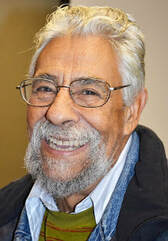 Rafael Jesús González, poet, activist, named first poet laureate of City of Berkeley, California, in 2017, and an esteemed contributor to Somos en escrito Magazine. This statement was written in Washington D.C., August 15, 2006. © Rafael Jesús González 2018.
0 Comments
Chicano ConfidentialBy Sonny Boy Arias I was attending a professional academic conference on the topic of the “psychology of the Self” that was interdisciplinary in nature, being held at the Marriot Hotel in Orange, California, not far from John Wayne International Airport. Upon arrival at the Marriott, I noticed that the hotel service workers were all very busy attending to multiple activities, a business conference, an afternoon meeting of the Lions’ Club, our academic conference, and, to my pleasant surprise they were setting up for an evening of pugilism, you know, good old-fashioned fighting, punching, hitting and, if we’re lucky, maybe some head butting. It was going to be an evening full of professional boxing and guess what? The “card” included women’s boxing! Yahoo! To say the least, the hotel was “buzzing.”As I entered the front door of the hotel I was not yet into the lobby when I was greeted by a large aquarium-like water dispenser stock full of fresh lemons located in the vestibule, the interstitial zone, the area between the front door and the lobby, the “in between,” a place where symbolically, I love to be and that most people find uncomfortable. So looking up to the morning sunlight, I closed my eyes and took a drink of the lemon water only to be disrupted by a pair of academics (you know the snooty types) speaking poorly of the age-old sport of boxing as well as those who attend boxing matches. “Can you imagine entering a ring with the objective to beat each other’s brains out?” one said, and the other replied, “What sort of people would attend such an event?” And then it occurred to me, these chaps were in attendance at the conference I came to attend. I also realized that I would much rather be at the boxing match. I was reminded of how many years I tried to develop of my academic colleagues as boxing buffs, but to no avail as they all looked down their noses at the sport I so well loved. As a result my enthusiasm was driven underground and I had to watch boxing events at home by my lonesome. I have to admit that the reason I like hanging out in the vestibule (interstitial zone) is because others always hurry through so I felt like I had the specially made water all to myself, it was a space where I could temporarily seek refuge from the morning hustle-and-bustle I experienced at two airports and a quick taxicab ride. As I drank the cool water I was reminded of a going away gift a friend once gave me the day prior to departing Texas for California: a water dispenser just as large as the one I was presently faced with and filled with several rows of pineapple and, need I say, vodka, seven times distilled. Thing is, because we were leaving the next day we had to drink the whole thing. There too rests a dichotomy as my academic colleagues were either non-consumers of alcohol or alcoholics. The unspeakable truth is that many of them stashed bottles of whisky in their university office files alongside their winter breath mouthwash to disguise the smell of alcohol. University professors are a “walking contradiction” in this way, always preaching one thing and doing something else. Concomitantly, we are trained to search for the truth in our subject matter and we always land-up masking our findings with illusions of the truth. In the “interstitial zone of life” you might say, you are neither here nor there but you are always discovering something new. As I looked around the hotel I noticed to my right, a sign-up table for my conference; it looked drab, and the people staffing the table looked just as drab, just like the stuffed shirts academics I knew I would meet up with later in the afternoon, so rather than sign-up for the conference I decided that it could wait so I immediately went to the left to the hotel registration desk, signed into my room and proceeded to the gym for a quick workout. The gym was average in size (not bad) and had some of the best equipment I had ever seen at a hotel gym, complete with treadmills with fans, widescreen television sets and what looked like an “aquarium” filled with fresh cut lemons and cool drinking water just like the one located in the vestibule near the front door of the hotel. I mounted the treadmill, set the fans on high and rapidly worked up to a good self-paced jog for twenty-minutes. I was set to leave and started pouring lemon water when as if out of nowhere a female boxer walked into the gym. She had a long black pony tail, was very fit, and had the appearance of a Chicana Hilary Swank in the fight movie “Million Dollar Baby” produced by Clint Eastwood. She wore a bright red robe with matching red Everlast boxing gloves and there were large silver letters across her back that read, “Tap Out, San Antonio.” I later learned that this was the name of her boxing gym. In a very nervous manner, she looked me straight in the eye and asked me how my workout was going. As I drank the cool lemon water she began to nervously shadow box all about the gym. I asked her if she was from San Antonio and let her know that I was living in Kingsville, Texas (just south of San Antonio). At this, she made direct eye contact and in a heavy Chicano accent told me about how this was her first time in “Loz Angeles.” She went on to say that she had come a long way to fight a well-known boxer (undefeated) from Los Angeles and that this was the biggest fight of her career with 8 wins, 1 knockout and 0 losses. She said that she was nervous and “a little afraid.” I told her that I loved boxing, had boxed as a young man for the Boy’s Club of San Diego, undefeated for two years and that I had often reflected upon my feelings of fear (when first entering the ring) but had come to a point of enjoying the feelings of fear; especially once I demonstrated some boxing competency to myself. Besides a good dose of adrenaline does the body good! I added that I had employed this strategy throughout my life and that today in my capacity as a social psychologist had come to inculcate this behavior in everyday life. In other words, I overcome fear by “diving straight into it,” the phenomenon that is causing the fear in the first place, that is, and always find that by doing so this method can assist with the fear factor. She caught my eye again and said she had earned a degree in psychology and business at the downtown San Antonio satellite campus of the University of Texas; I had once consulted there for start-up development. She did not work out long as it appeared that she had some nervous energy to keep in check. As she worked the stair-stepper, she jabbed into the air as professional boxers often do. After ten minutes or so her manager came by, knocked on the window and just before exiting the gym, she turned and invited me to the fight. I told her I would be there “in her corner.” Now that I think about it, I noticed that she had a quick conversation with her manager, pointed to me, and left the hallway. After my workout, I took a shower and tried to psyche-up for conference mode. I walked through the “buzz” generated by hotel personnel and signed-up for my conference at the conference desk with a rather bored looking woman who afforded me a mountain of materials along with a sizeable name tag and one-hundred percent cotton bag made by some poor kid working out of a sweatshop in Bangladesh. Now that I was all “labeled” up, I could identify myself with several hundred other colleagues all walking around the hotel aimlessly or talking on their cell phones acting as if what they were talking about was somehow important. As I sat through the conference workshops that morning I made it a point to get up and walk the hallways of the hotel about every forty minutes. Frankly, I did so mostly out of boredom (I just have to be honest with you), to get some exercise and also to pee as I was on “pee pills” as part of my kidney stone regimen. Our conference was being held on the furthest side opposite the front door of the hotel, maybe some fifty yards away. In between our conference room and the front door was a very large hall where the evening fights were going to be held that looked like it could fit up to 2,000 people; it actually looked like a ballroom. There were any number of vendors, service and lighting people, and professional boxing types everywhere. I must say this certainly made my trips to the restroom quite interesting. As I walked the hallways of the hotel I kept asking people where I might purchase a ticket for the fights. Well, it soon became common knowledge that the fight was sold out. I understood this but I kept asking anyway and felt that the $28 dollar investment would be well worth it and at the same time give me an excuse not to hang-out with the stuff-shirt academics who only wanted to talk about their boring work. In search of tickets I happened to meet the promoter of the fights near the giant Tecate beer bottles being set up near the main bar. He acted busy so I was surprised he gave me a few minutes of his time as I asked him a number of questions, like how many fights were there going to be, who was fighting and the like. After this conversation I noticed a guy who looked like a “ticket scalper” and asked him if he had tickets; he did not, but he did encourage me to keep checking with him and I heard him on his cell phone trying to locate a ticket for me, these were all good signs and at the same time reified in me my tenacious behavior. Later that day, on another trip to the restroom I noticed some people wearing “Tap Out” shirts setting up a booth with pictures of what looked like the female boxer I had met in the gym. A young woman (that looked like the boxer’s sister) said I had to go to the fight to watch “Norma kick some ass.” I found her confidence contagious and even a little intimidating and agreed. Just as she directed me to purchase a $9 picture with “Norma Cha Boom Boom” she (Norma) came around the corner out of the staging room, how could I refuse to purchase a picture? The camera was not yet set-up, but the “sister” gave me the “look” as if to say “Why not just purchase one of these pictures asshole we need the money” so I placed the $9 in the plastic jar, said a few encouraging words to Norma and decided to walk through the “staging room” where both male and female boxers were hanging their garments, taping-up their hands and getting ready to mostly kill time by shadow boxing and of course to “talk shit” about their opponents. I could tell that “Norma Cha Boom Boom” was real tough, a street fighter who rest assured could take a lot of pain and give some, too. My sense is that she is probably a better fighter with her gloves off and out of the ring on the street some fighters are just that way, hence, they might lose in the ring, but they will always win a fight on the street. The paradox is simply there are far too many rules to follow in the ring it’s not like back in the day. Each boxer had a very small area in this large room where they would prepare themselves for the fight, there were both male and female boxers, their managers and their “handlers” just like the ones I had just met selling pictures. I was now an official “Norma Cha Boom Boom fan” and was determined to go to the fights that evening. I returned to my academic conference and found a speaker, a professor of rhetoric from the University of Pennsylvania, preparing to give his lecture. I also noticed a number of copies of a very thick book (over 500 pages) placed at every table. It was a book written by the speaker (“good old what’s his name) and the subject matter was “self-development for adult learners.” Anyway I sat about three tables down from the podium where he was addressing over 300 academics from a variety of disciplines. At one point he conducted an exercise asking every table in the room to meet for a few minutes and come up with a definition of the word “plisky.” Beyond working in collaboration with others, I am not sure what the point of the exercise was, but the speaker made it a point to tell the audience that he had spent two hours trying to identify a word that “this group” (Ph.D.’s) might not know the definition, so each table came up with a definition, presented it to the greater group, and by a show of hands, each respective definition was either accepted or rejected by the entire group of 300. It didn’t take long to reject a number of excellent definitions. At our table, like all of the other tables, no one was forthcoming with a “true” definition. As a group we lacked vibrancy and imagination, the exercise was suddenly boring and uneventful. Even though I was not feeling it and didn’t really care to collaborate with others at my table (as I was busy trying to figure out how to get a ticket to the fights), I shared my knowledge of a “plisky” and told them how I knew what it was. This is what I shared. While serving as a Dean of the College of Arts and Sciences at Texas AandM University, I told them, I once proposed to the Chancellor’s Office that we fund a Center of Excellence every two years. The Chancellor thought this was a “great idea,” funded our university, and as a result we competed for the prize within our own university. I reflected upon the “excellence” I found in each of my 18 departments and ascertained a need for a grand Steinway piano in the Music Department. I was convinced that the only way we would attract top artists was if we had a Steinway, as artists will often not provide a concert without a Steinway or Kawai piano. So I met with the chair of the Music Department with the idea of writing a proposal for this purpose. He told me that he loved the idea but had never written a proposal. At this, I told him I would write the proposal on his behalf as long as he didn’t tell the other chairs that I had done so; since I could not focus in my Dean’s Office I set up a time to visit the Music Department to find a place to write. The chair took me into a piano room with no windows but with a few hundred boxes of old sheet music that smelled like musty paper and a very old Bösendorfer grand piano (a unique prototype made in Vienna) stacked high with even more sheets of music. Suddenly, without warning he stretched his arm out across the top of the piano and moved it rapidly from one end to the other, clearing everything atop the piano to the floor; “now you have work space,” he blurted, smiled, and walked away. It took me about three hours to write the proposal that was subsequently funded for around $700,000. Again, it was the first award in the Texas AandM University System of its kind. I had proposed it, and I was proud of the fact that it was awarded to our Music Department. With a sizeable check in hand I immediately made contact with the Steinway Piano Corporation in New York City and they in turn placed me in contact with their representative in their Houston corporate office. I was invited to the “Steinway showroom” in Houston. I must say that all of the Steinway people I had met were very professional. They began our meeting with champagne and a brief history of the Steinway piano. I learned that only a particular kind of wood from the Black Forest in Germany was used to make their pianos because it was that particular forest where the Steinway Family was having a picnic one afternoon when lightning struck, killing the entire family with the exception of one man who (at the time lightning struck) heard a significant tone (a reverberation of a sort) in the trees. It was that sound and that event that changed the life of young Steinway. 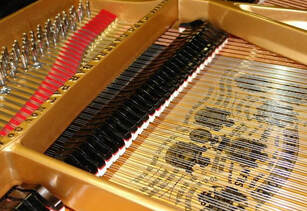 At the same time, Steinway pianos are known not to utilize wood glue to hold the pieces inside the piano together. Rather, the wood is placed in such a manner so as to hold itself together, using wooden doles and support design. At the same time, each piano key stretches from the front side of the piano (ivory key side) into the inside of the piano through an extended wooden arm, and at the end of the arm is a “hammer head” made of hardened felt – that is the “plisky.” A professor in the room (someone I had never met) reified my definition by adding that once he had worked for the Hammond Organ Company and that my definition was true. I think he was simply full of himself and wanted others to know that he had a life outside of academe. I successfully argued that the “plisky” was the part of the hammer made of hardened cotton that struck the piano string. The “plisky” is located beneath the black hammers in this picture, but of course my point is that it was not true, I was dreadfully bored and was looking for a cheap thrill, plus, I just wanted to be powerfully convincing and I was. Read on. The entire group of 300 cheered at my story and voted mine as the best definition of the word “plisky.” Fact is, when the speaker read the real definition of the word, “plisky,” no one believed him. He said that according to Webster’s Dictionary a “plisky” was a joke, something made up as when someone “kids around.” When I told the group that I had made up the definition they did not believe me! It took some re-explaining to undo as several of them became adamant and few were on to my boredom and trickery. Following the “plisky exercise,” I took a break and sought refuge in the hallways only to run into Norma, the female boxer. She said that the fighter she was originally matched-up with was a “no show” and that she would now be matched-up with “that girl over there,” a young woman dressed in “Irish greens” with red hair, big freckles, and bright green eyes who looked like she possessed a thick Irish accent and could hold her own in the ring, Norma sensed that the young woman was a “push over” and said as she shook her head, “Look at her, now what a plisky that is!” 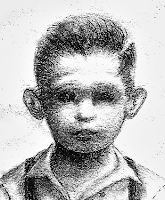 Sonny Boy Arias, a dedicated contributor to Somos en escrito via his column, Chicano Confidential and a stone-cold Chicano, has been on hiatus while on a world tour of Europe and the Subcontinent telling stories. He writes under the general rubric of historias verdaderas mentiras auténticas–true stories and authentic lies. He has found this the most effective manner to convey his stories about Chicano life. Copyright © Arts and Sciences World Press, 2018. The Duel of the SmileysBy Alvaro Huerta My mother Carmen often sent me to La Paloma Market, while my brother Salomon watched I Love Lucy re-runs. We lived in East Los Angeles’ Ramona Gardens housing project, where I had to be selective about the routes I took. Since I feared the barking dogs along the alley, I always took a shortcut through the hill that was controlled by a local gang—the Hill Boys. The homeboys never bothered me on my daily trip for groceries, especially since we attended Murchison Elementary School at the same time. It wasn’t until one hot Saturday morning, on my way to La Paloma, when one of the homeboys called me out for a fight. His name was Javier, an inductee of the Hill Boys who challenged me for my nickname, Smiley. A veterano gave me this nickname because I was always made him laugh. Eventually, everyone called me Smiley, including my parents. Although I never belonged to a gang—my application was rejected because I was too thin—I could never show signs of weakness or else I would become easy prey on the mean streets of the Eastside. Despite my initial reluctance to fight, Javier and I were to exchange blows, not for any grudges or personal issues, but for the right to be known as Smiley #1. Long before our fight, Javier and I would bump into each other at the hill on our way to La Paloma Market. We would acknowledge each other with casual nods of the head. During these encounters, we established a friendly relationship, despite our obvious differences. While I sported my Los Angeles Lakers jersey with my K-mart Lee’s jeans and Converse sneakers, Javier strutted along with the traditional gang attire—a neatly creased, white JC Penny T-shirt with brown, baggy khaki pants and Stacy Adams shoes. He also never left home without his Pendleton coat, neatly folded around his arm. He was a wannabe cholo back then. But our casual relationship changed that one Saturday morning, as Javier was being initiated into the Hill Boys. To become a Hill Boy, the inductee had a choice of either walking through parallel lines of homeboys to suffer hits and kicks until reaching the end, or fight against three of the toughest homeboys, while the other homeboys count up to ten. Javier chose the latter. As I watched Javier’s initiation from a safe distance, I witnessed his futile attempt to fight back against an onslaught of blows. “One, two, three, four…,” the homeboys slowly counted up to ten. Javier stood up as long as he could, but his knees finally buckled at the count of eight. The homeboys finished the last two counts with kicks to Javier’s back and legs. It ended with a loud “¡Basta!” Herbie, one of the homeboys, got in a last kick to Javier’s left shin. “Congratulations, man, you’re one of us,” yelled Duke, the gang leader. Javier slowly rose to his feet and tried to dust himself off. His neatly pressed T-shirt now sported rips, dirt and blood. All of the homeboys welcomed him with a bear hug. Almost in unison, they asked Javier to decide on a gang name. “Smiley,” he shouted, grinning with blood and dirt on his teeth. “You know that Smiley is already taken,” said Duke, as he glanced and pointed in my direction. “Choose another name, man.” “Well, why don’t we just duke it out for the name?” Javier asked. “Come in closer, Smiley,” yelled Duke, as he nodded at me. “You’ve been challenged to a fight. What’s it going to be? Are you going to fight or chicken out?” As I approached the homeboys, I thought about the promise I made to my mother that I was not to take part in gang activity. Since my nickname was not gang related, I didn’t feel obligated to defend it. It was just a nickname, I thought to myself. For Javier, however, it was more than a nickname. It was his new identity. It represented his new way of life: a proud member and defender of the Hill Boys. And there could only be room for one Smiley #1. As I got closer to Javier, he began to mad dog me. At that point, I had no way out. I was the only thing standing in his way to become Smiley #1. “No, Javier,” I said. “I don’t want to fight.” Before I could finish, Javier rushed at me, swinging in all directions. “Who are you calling Javier?” he shouted, coming at me with full force. “I’m Smiley #1, punk!” I put my hands up and started to fight, trying to defend myself against a determined foe. After two minutes, Duke broke us apart to see if I wanted to quit. “I’m down to keep going, if he’s down,” I said, knowing that quitting was not an option in my neighborhood. Waiting for a verbal response, Javier suddenly hit me on my chin. I went down like George Foreman against Muhammad Ali in the “Rumble in the Jungle.” “One…two…three…,” one of the homeboys counted. “You’re out of there,” proclaimed another homeboy. I slowly opened my eyes, trying to bring the homeboys’ faces into focus. “And the winner and new champion, all the way from the big, bad Hill Boys gang,” shouted an exuberant Duke, as he raised Javier’s arm up in the air, “Smiley #1.” As the applause dwindled, Javier helped me to my feet and gave me a hug. “Thanks for helping me up, Smiley,” I said to him with a look of defeat. “I have to go now. My mother is waiting for her tortillas de maiz and chicken.” When I got home, my mother asked me, “What happened to you?” “¿Qué?” I blurted out, pretending that nothing was wrong. She looked up at me, before inspecting the grocery bag. “You’re a mess, Smiley. And why did it take you so long?” “Oh…uh…I was chased by some dogs and fell,” I said. “How many times do I have to tell you not to go through the hill?” she scolded me. “Well, I need you to return to market and return this chicken. It smells.” “Why do I always have to go?” I said, as I shot a glance at my brother Salomon. “Why don’t you send him?” “You know that I can’t rely on your brother. He always forgets to get everything I ask him for,” she explained. “Maybe he forgets on purpose?” I responded with respect. Salomon kept quiet, concentrating on I Love Lucy. I’m sure he heard everything we said, however. A little grin crept across his face, yet I couldn’t tell what amused him more—my predicament or the television program. “Okay, I’ll go back,” I said, “but under one condition.” “What?” my mother asked. I paused for a moment and coughed. Salomon was still slouched in front of the TV, as I noticed his eyes shifting toward me. “Well?” said my mother, “I don’t have all day.” “Please,” I said in a clear voice, “I don’t want anyone to call me Smiley, anymore!” My mother shook her head, turned on her heel and walked to the kitchen without saying a word. Salomon’s eyes turned back to the television, where he let out a little laugh. I walked to the front door. “Have fun,” said Salomon, as I stepped out onto the porch. I let the screen door slam behind me, nervously anticipating what darkness awaited me in the projects. 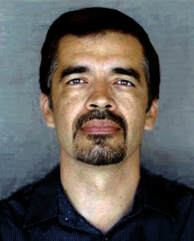 Alvaro Huerta, an assistant professor of urban and regional planning and ethnic and women’s studies at California State Polytechnic University, Pomona, is the author of Reframing the Latino Immigration Debate: Towards a Humanistic Paradigm (San Diego State University Press, 2013). This story, originally titled, “Los Dos Smileys,” was first published in Latinos in Lotusland: An Anthology of Contemporary Southern California Literature (Bilingual Press, 2008), edited by Daniel Olivas. Sex and the Second Graders “What’s sex?” Helen’s faint, wistful query had come out of nowhere, stopping us cold, leaving us holding partially gnawed apples or cookies or unfinished sandwiches suddenly gone dry and hard to swallow. Just moments ago our small group of seven second grade friends had been companionably eating lunch at our assigned place, one of the well-worn brown-painted wood and cement benches lining the left side, the girls’ side, of St. Agnes School’s upper playground. It was, we thought, the best bench of them all. The central decoration, the focus and pride of our schoolyard, was an imposing outdoor shrine facing the school’s main entrance, a life-size gray cement cave or grotto sheltering a statue of Our Lady of Lourdes. Tall arching trees, green shrubs and rosebushes growing along the fence line provided the shrine, and our adjacent bench, a welcome feeling of privacy and peace. Leave it to timid, wispy-haired little Helen, youngest and smallest of our circle, to disrupt that peace. Didn’t she know that “sex” was one of those intriguing socially unacceptable words we weren’t supposed to know, and never ever supposed to say out loud, in public? Obviously not. She was so dumb! With leftover sandwiches and snacks returned to colorful metal lunch pails, our immediate mutual instinct was to check if the coast was clear. Where was today’s playground monitor, and who was she? No way did we want our discussion to be overheard, especially by bossy, crab-faced Mrs. Baxter, the tall lady with the tight blonde perm who sometimes filled in as supervisor. Our heads swiveled back and forth as we peered through the blur of almost two hundred uniformed students: white-shirted boys in navy cord pants, girls in white middy sailor blouses worn over pleated navy skirts. “There she is,” red-haired Millie whispered, tossing two long auburn braids behind her shoulders, “…over by the boys.” A collective sigh of relief, the coast was clear, we were safe. Today’s supervisor was popular and always amiable Sister Mary Francis, busy settling a problem on the opposite side, the boys’ side, of the playground. Sister’s billowy black floor-length habit and black veil over a starched white coif made her a formidable, highly visible presence, even against the sea of navy blue and white. Helen’s unanswered question still hovered overhead, filling the atmosphere with a heavy uncomfortable silence. I couldn’t stand it. Somebody had to go first; it might as well be me. I swallowed the rest of my bite of apple, cleared my throat, gathered up a bit of courage, forced out an answer. “Sex means whether you’re a boy or a girl. You know, those boxes our parents mark with a pencil on school or doctor forms.” The words had barely slipped out when I knew it was too simple, too easy an explanation. Barbara’s brown Shirley Temple curls went flying as she shook her head in disagreement. “No, sex is holding hands with a boy.” Millie, then the others chimed in. “Yuck! Who wants to do that?” “No, it’s when a boy kisses you and you kiss him back.” Suzie objected. “Well, my grandpa used to be a boy, sometimes he kisses me, and I kiss him back!” “That’s different!” “Why?” “Boys stink!” “It’s something that happens when boys and girls cuddle up too close together.” “Double yuck!” “It’s about grown-ups.” “No, sex is about teenagers, not old people, and there’s got to be kissing!” “You’re all wrong! Sex has to do with babies!” Back and forth we went, each contribution adding to the muddle. Then Mary (the smart one) issued her opinion. “No, there’s more to it than that, lots more,” she declared in a slightly superior tone. “Sex is about grown-ups, not teenagers. A man and a lady like each other, they get married, they have children.” A great silence followed Mary’s declaration. Well, that’s that, I thought, end of discussion. Mary, of all people, should know; she was part of a big family with lots of brothers and sisters. Besides, Mary’s father was a lawyer, and everyone knew that lawyers, and by association, their children, were extra smart. But no, that wasn’t that, after all. After a few more silent moments somebody else, I think it was Joan, spoke up. Yes, now I remember. Joan, not to be outdone (she was oldest, after all), brought up another subject we weren’t supposed to discuss. “Well, sometimes ladies have children without being married. What about them?” I don’t remember what Mary or anyone else answered, but Joan was on a roll, and not about to be silenced. Tucking some wayward strands of wavy dark hair behind her ears, she continued. “And besides, what about men who like men? We’ve all seen them kiss and hug. What about them? Men don’t get married to each other, and men sure can’t have children!” A collective gasp, then another long quiet pause as we thought this over. I just knew we were all remembering the same thing. Last Friday, over blaring classroom speakers, The Office had emphatically announced a new rule: Effective immediately, nearby Buena Vista Park would be off-limits to all St. Agnes students. Parents and teachers alike were in complete agreement, The Office proclaimed. “But why?” I asked my father later that same night. “It doesn’t make sense, it’s not fair, parks are supposed to be for everybody!” “That’s just the way it is, that park is for men only and you’re never to go there,” Papi answered, putting an uncharacteristic end to any more questions from me regarding that particular topic. Our group drew in closer, heads touching, hands gesturing, to discuss this new topic. We were all accustomed to Middle Eastern men walking hand-in-hand, a familiar sight in mid-1940’s multicultural San Francisco. No one cared, hardly anyone noticed, except maybe tourists. But other men who did this were different, somehow; we just knew. Finally, by mutual agreement, we quietly decided that yes, sex had something to do with men, too. Still, exactly what it was none of us had any idea. We weren’t quiet for long. Frowning, a puzzled Barbara posed a new question. “Well, if men can like men, do ladies ever like ladies?” Another explosion of opinions followed. “That’s impossible!” “Ladies don’t kiss each other!” “Why not?” Suzie again: “My aunties kiss and hug me, and each other, all the time!” “That’s different!” “Why?” “That’s crazy!” “Yuck!” “No way!” “There’s no such thing!” By now, all caution flung aside, we were practically shouting at each other. “Well, why not?” I countered (the voice of reason). “It makes sense. It’s only fair. If men can like each other, then why can’t ladies? What’s the difference?” Little Helen spoke up again, this time in an impressive, never-before-heard-aloud voice. “Let’s ask Sister! She’ll know! And she won’t lie to us like our parents sometimes do, because she’s a nun, and nuns can’t lie. They’d go straight to hell!” “Good idea!” “You ask her!” “No, you do it!” “You thought of it first!” Somehow (because I was tallest?) they picked me to be spokesperson. There’s strength in numbers, they say. Or maybe it’s strength in courage. Whatever. So, hoping one or both sayings were true, I stretched out my hands to my six friends. “There she is,” shouted Millie over the rumble of other voices celebrating their release from lunchtime constraints. “…over by the boys, next to the main stairs!” Clinging to each other, seven sets of fingers tightly interlaced, we set out in search of Sister Mary Francis, carefully making our way through a sudden surge of students. The hand bell signaling the end of lunch and beginning of free play had rung. We hadn’t even noticed. Sister gave us her customary warm smile as we approached. “Yes, girls? May I help you with something?” I spoke up, body trembling, knees knocking, appallingly aware of my duty as spokesperson. “Yes, Sister, we need to ask a question. You know how… sometimes… men like other men?” I paused to gather up another bit of courage before continuing. “So… do ladies ever like… other ladies?” Sister’s smiling face still beamed; then, as she realized what we were asking, she gasped, exhaled, stopped breathing. Paralyzed, horrified, we watched Sister’s complexion change from normal to a pale, chalky white, almost as white as her coif, then to an alarming crimson. Oh no! Was she mad at us? Was she going to yell at us? Were we in big trouble? Would we be sent to The Office? Would they call our parents? And what if Sister Mary Francis fainted, or even died? It would be our fault! Obviously, we had accidently stumbled across yet another one of those socially unacceptable questions. I felt so dumb! At last… Sister gasped, breathing in gulps of fresh air as her complexion slowly regained its natural color. More long seconds passed before Sister forced out an answer to our question. In a dreadful high dry squeak, like the sound that comes out when you try to talk after inhaling the air from a helium-filled balloon, Sister blurted out: “Yes, it happens, but it’s very, very rare!” “Thank you, Sister,” we chorused before scrambling away, zig-zagging through boisterous clumps of rampaging boys, back to the girls’ side, back to the security and serenity of our own designated bench by the grotto. Could we believe her or not? We weren’t sure. We still liked and respected Sister, and she had, after all, answered our question. But nun or not, Sister Mary Francis’ reaction wasn’t very convincing or reassuring. Learning the truth about sex was obviously going to be up to us, without any adult help. Maybe next year, when we were older and smarter, when we finally reached third grade, maybe then we’d understand more about it. 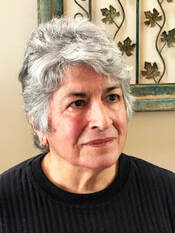 Gloria Delgado, born and raised in San Francisco’s Haight-Ashbury district, is the daughter of a Mexican father and a Hawaii-born Puerto Rican mother. She and her husband live in Albany, California. One of her stories, “Savanna,” was included in the Berkeley Community Memoir Project’s recently published collection, “A Wiggle and a Prayer.” This is her third story for “Somos en escrito.” |
Archives
June 2024
Categories
All
|
Donate and Make Literature Happen
is published by the Somos En Escrito Literary Foundation,
a 501 (c) (3) non-profit, tax-exempt corporation. EIN 81-3162209



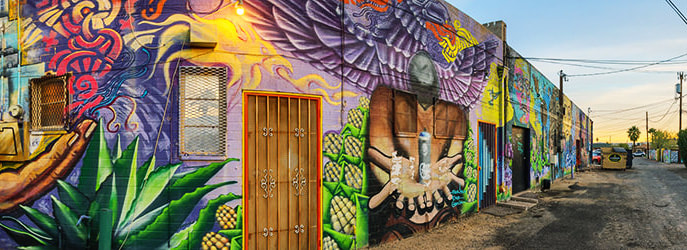

 RSS Feed
RSS Feed